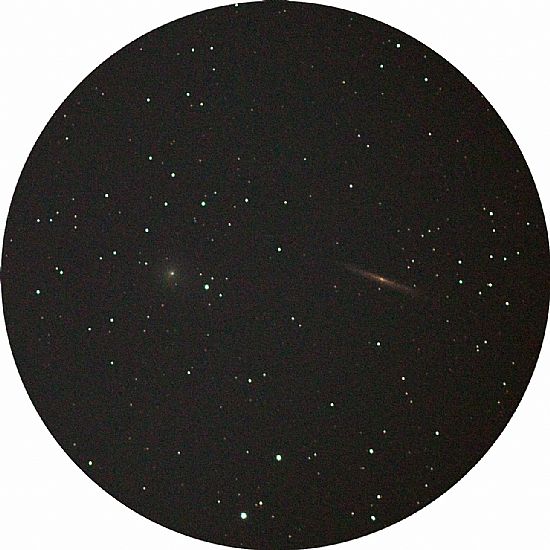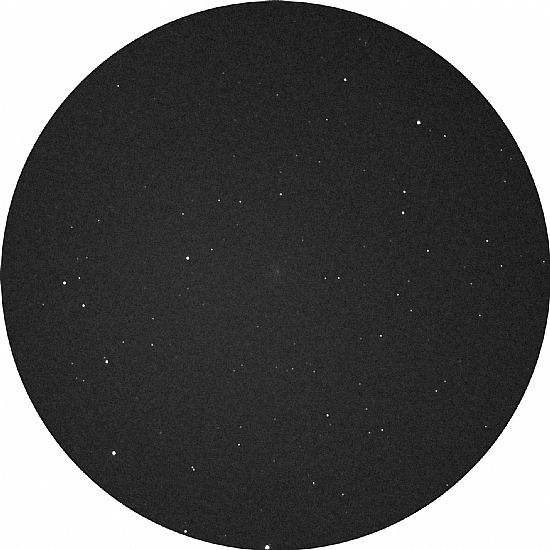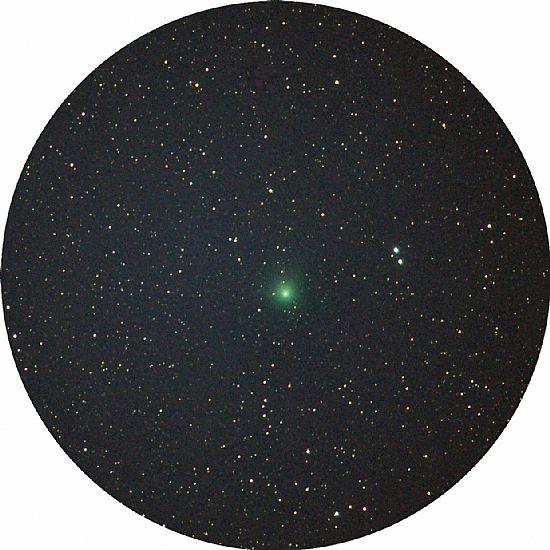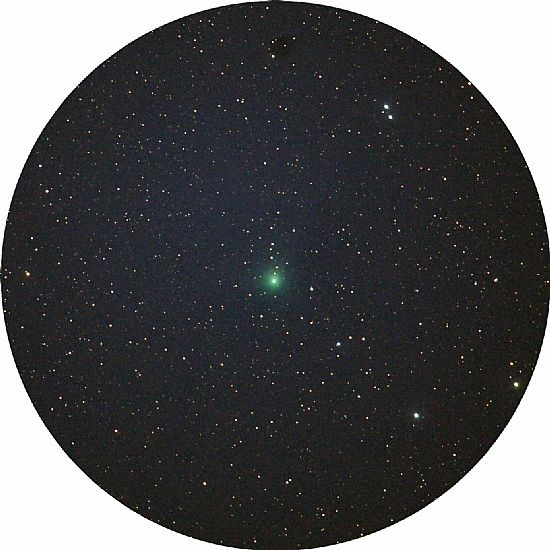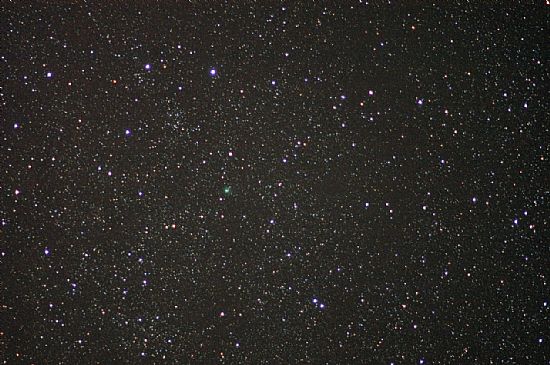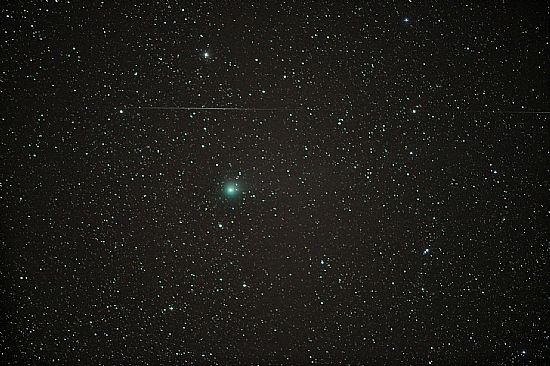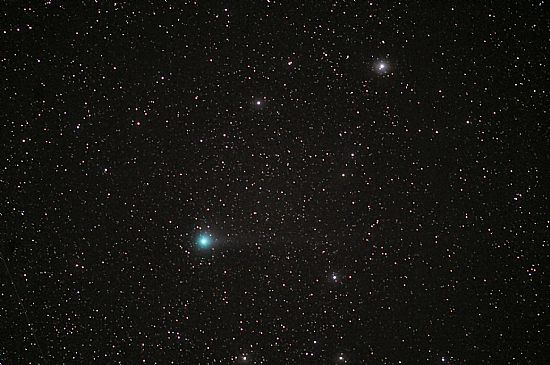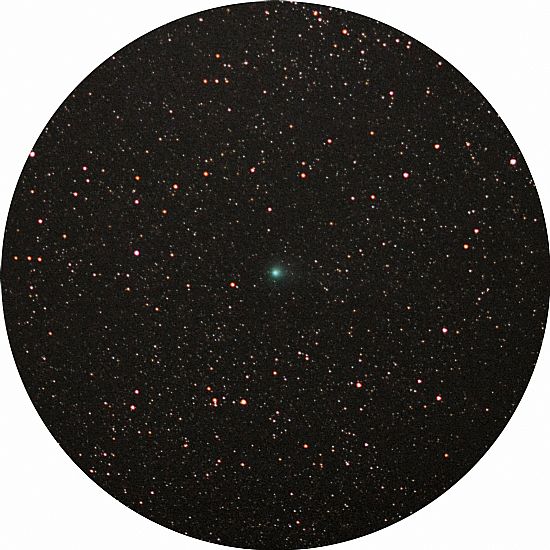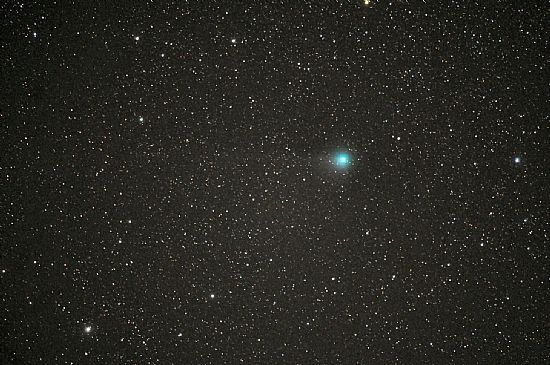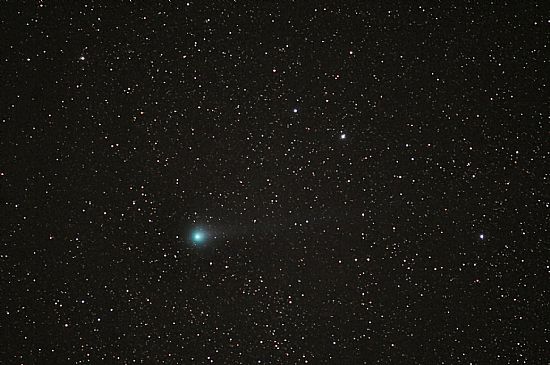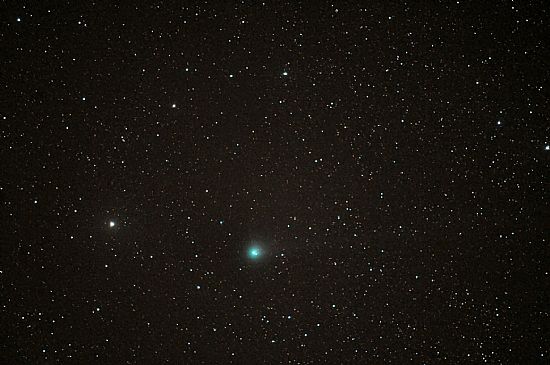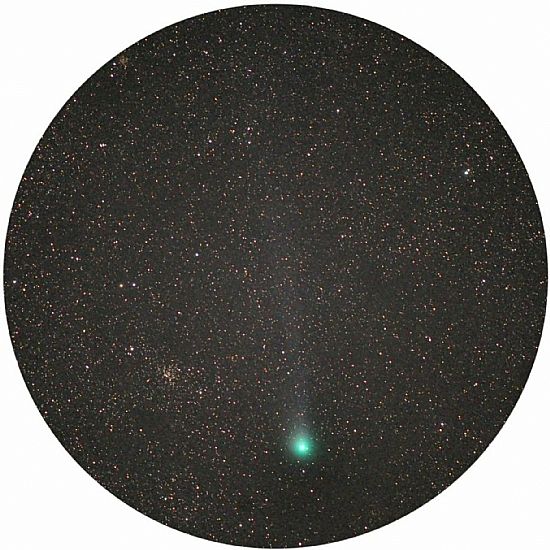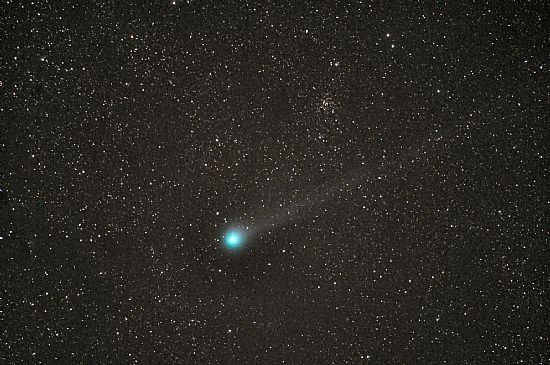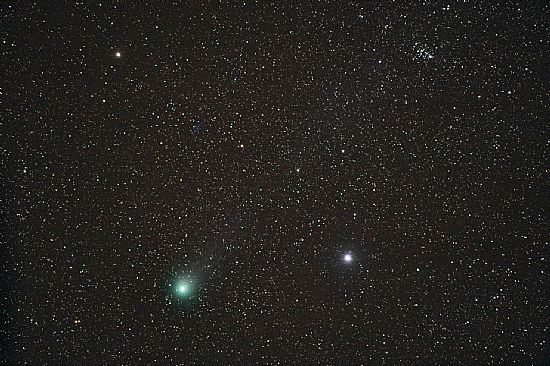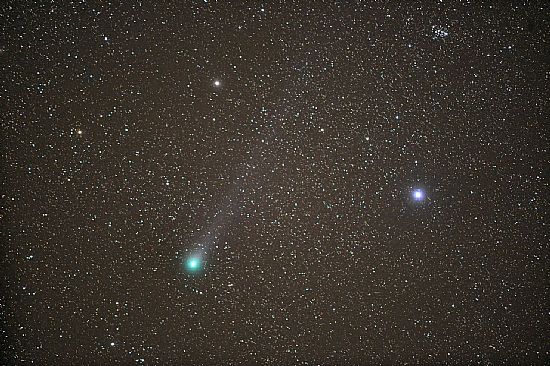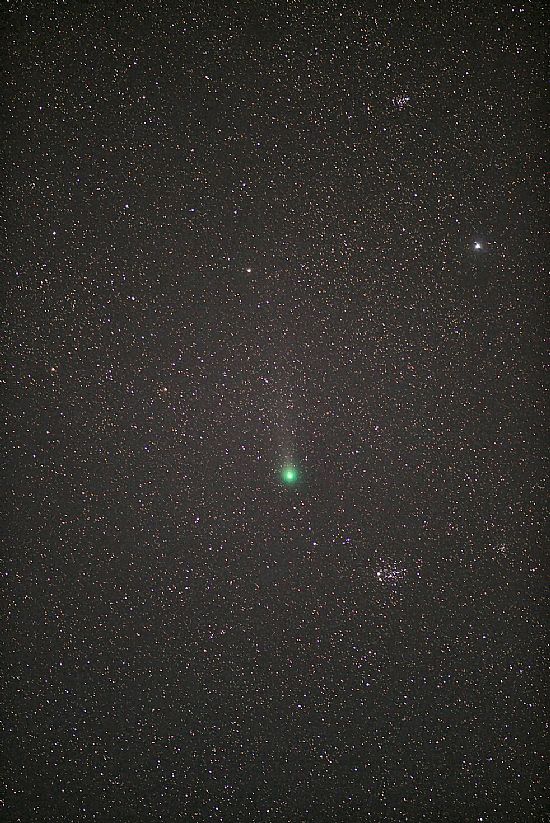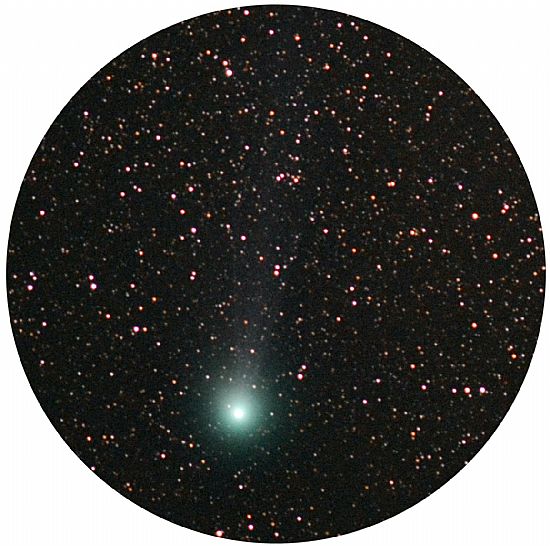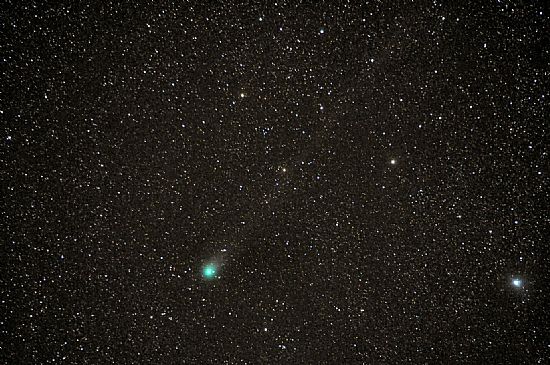 NORTHERN SKIES | sitemap | log in NORTHERN SKIES | sitemap | log in
|
 |
||
| This is a free Spanglefish 1 website. | ||
Comet C/2014 Q22015 October 08 continuation on C/2014 Q2 OEVERFLOW
2015 October 04 A good night for seeing quality but frustrating for transparency with cloud forming and dispersing, in addition to moving light cloud patches on a fresh S wind. Difficult to fix an exposure time with cloud likely to intervene before completion; additionally, a number of artificial Earth satellites crossing the line of sight.
2015 October 04 Comet C/2014 Q2 Lovejoy. 150mm aperture f/.5 achromatic refractor. A 58.4 sec exposure, D800 SLR ISO 2500. The brightest star in the field (dia. 48' approx.) is TYC 2583-149-1, visual magnitude7.92 spectral class K5. (Limiting magnitude 16.5.) Note: the colour correction is poor with this achromat. (Left click to enlarge.) Question: Why use a lens system of inferior colour correction when we have far superior lenses available? The combination of speed (f/5) aperture (150mm) and focal length (750mm) judged appropriate for the comet's distance and local conditions. This instrument is equipped with a wide-angle finder 'scope enabling us to make the initial equatorial settings faster than with a camera lens. Moreover, the images are sharp - a little colour distortion is relatively unimportant. Comet's data at tine of observation: Estimated integrated visual magnitude: 12.1 Right Ascension: 16h 20m 32s Declination: +32° 38' 48" Constellation: Corona Borealis Altitude: 33° 51' Azimuth: 278° 17' Elongation: 63.7° Distance: 3.8225 AU (571.9 million km) Radius vector: 3.4967 AU (523.1 million km) Horizontal parallax: 2.30"
2015 September 13
2015 September 13, 22h 42m UT. Comet Lovejoy (at centre of field) imaged Nikkor 500mm f/4, D800 SLR ISO 2500. Exp. 44.1 sec. The brightest star in the field (dia. 1.4° approx.) is TYC 3054-2093-1, visual mag. 6.30, spectral class. K0. Limiting mag. 15.5. (Left click to enlarge.) Exposures were compromised by an all-pervading, moderate auroral glow. Data for comet at time of observation: Constellation: Corona Borealis Right Ascension: 15h 57m 45s Declination: +39° 12' 26" Altitude: 32° 9' Azimuth: 293° 49' Hour angle: 6h 6.2m Elongation: 70.6° Distance: 3.4729 AU (519.5 million km) Radius vector: 3.2796 AU (490.6 million km) Horizontal parallax: 2.53"
2015 September 10 The first opportunity for working in a dark, clear sky for eighteen days. A NW airflow has kept skies overcast by day and night restricting observations of the Sun likewise. Quite depressing!
2015 Sep. 10, 22h 41m UT Lovejoy Brightest star in the field (1.2' dia. approx.) is TYC 3054-1406-1 visual mag. 8.16 spectral class A2. Nikkor 800mm f/5.6, D800 SALR ISO 2500. Exp. 134.2 sec. (left click to enlarge.) The ringed area at its centre shows the galazy NGC 6013 magnitude 13.6, size1.4'x0.8'. Exposures were severely compromised by an intense auroral glow (see auroral page) not helped by moderate transparency and variable seeing stability.
2015 August 23. A clear sky following a day of almost clear skies but poor transparency. The nigh sky transparency slowly improved until morning twilight took over in the early hours of the 24th. A strong (force 6-7) SEE wind moderated slowly during the course of the night. Not easy! Observations of Comet C/2014 Q2 (Lovejoy) were made with both 600mm f/4 and 800mm f/5.6 Nikkor lenses in combination with the d800 SLR. High resolution images still show a short tail. Early morning observations (Aug. 24) were conducted with the 400mm f/2.8 in Gemini in the hope of locating Comet 67P/Churyumov-Gerasimenko but without success. The comet was below altitude 8° in an area of growing twilight and light pollution from the ground. Images did, hovever, show stars to vis. mag. 15.5.
2015 August 23, 23h 23m UT. A 66.5 sec. exposure Nikkor 600mm f/4 and D800 SLR ISO 2500. Brightest star in field (dia. 1.5° approx.) is TYC 3483-1859-1, visual mag. 5.76 ,spectral class F2V. Limiting mag. 17. (Cropped image.) Comet's data at time of observation: Right Ascension: 15h 35m 32s Declination: +47° 20' 10" Constellation: Bootes Altitude: 40° 57' Azimuth: 296° 26' Elongation: 75.9° Distance: 3.1453 AU (470.5 million km) Radius vector: 3.0594 AU (457.7 million km) Horizontal parallax: 2.80"
2015 August 16. Comet C/2014 Q2 Lovejoy. A very poor night following a day of excellent transparency but deteriorating as night approach. Cloud coming and going, dispersing within seconds making for a frustrating time at the telescope with few opportunities for seeing anything!
2015 August 16, 23h 3m, UT: Comet C2014 Q2 Lovejoy imaged Nikkor 800m f/5.6, D800 SLR. A 75.6sec. exposure, ISO 2500. The brightest star in the filed (dia. 1.0° approx.) is TYC 3488-989-1 Vis. magnitude: 7.66 spectral class: K5. (Limiting visual magnitude 17.) Data for comet at time of observation: Right Ascension: 15h 28m 22.0s Declination: +50° 22' 32" Constellation: Bootes Altitude: 44° 23' Azimuth: 297° 36' Elongation (from Sun): 77.0° Distance: 3.0449 AU (455.5 million km) Radius vector: 2.9854 AU (446.6 million km) Horizontal parallax: 2.89" See the Gallery page for observations of August 15.
2015 August 04. Comet C/2014 Q2 Lovejoy.
2015 August 04. Comet Lovejoy imaged at 23h 45m UT. Nikkor 800mm f/5.6. A 52.0 sec exposure D 800 SLR, ISO 2500. The brightest star in the field (dia. 1.2° approx, ) is STT 294 vis. mag, 7.53 spectral class A2. Stars to magnitude 15 are visible despite twilight and presence of Moon. Cropped image..(Left click on image to enlarge.) The galaxy to the right of the comet is NGC 5907 ("Splinter Galaxy"), integrated vis mag. 10.4, apparent angular dimensions: 12.6'x1.4'. The proximity of NGC 5907 was fortuitous, enabling one to make a more reliable estimate for the comet's own integrated vis mag. which we would put at 11.0, slightly brighter than the estimate of 2015 July 27. Conditions at time of imaging: astronomical twilight (Sun's altitude -13° 33' ). Moon Phase 73.2% Constellation: Pisces Altitude: 15° 18' 59" Azimuth: 108° 32' 0" Comet's data for 2015 August 04 23h 47m UT. Right Ascension: 15h 16m 30s Declination: +55° 55' 11" Constellation: Draco Altitude: 50° 2' Azimuth: 301° 7' Elongation(from Sun): 78.3° Distance: 2.8859 AU (431.7 million km) Radius vector: 2.8582 AU (427.6 million km) Horizontal parallax: 3.05"
2015 July 26/27. Comet C/2014 Q2 Lovejoy.
2015 July 26. Comet Lovejoy imaged at 23h 42m UT. Nikkor 500mm f/4. An 8.0 sec exposure D 300 SLR, ISO 2000. The brightest star in the field (dia. 1.2° approx, ) is HDS 2127, vis. mag7.67 Spectral class: F2. Cropped image, greyscale. Stars to magnitude 14 are visible despite strong twilight and fine cloud. (Left click to enlarge. Comet at centre of field. Greyscale, cropped image.) The comet's integrated magnitude is difficult to assess under these conditions but is likely to be in the region of12.5 mag. The comet was last observed 2015 May 8/10. (See below.) Data for comet at 2015 July 26 23h 42m: Right Ascension: 15h 8m 3s Declination: +60° 19.1' Constellation: Draco Altitude: 56° 4' Azimuth: 303° 8' Hour angle: 4h 43m Transit: 18h 59.8m Elongation: 78.6° Distance: 2.7781 AU (415.6 million km) Radius vector: 2.7623 AU (413.2 million km) Horizontal parallax: 3.17"
2015 May 09/10. Comet C/2014 Q2 Lovejoy. The daytime of the 9th followed a similar pattern to that of the previous day, skies clearing as sunset approached and leading on to an even clearer night. Observations for Comet Lovejoy commenced at around 23 40 UT with both Nikkor 500mm f/4 and 800mm f/5.6. Our recent night's observations (May 08 – 10) for the comet are likely to be the last until well after summer solstice. We might hope to resume work on the comet from the second week into August. More information will be given in early August.
Comet C/2014 Q2 Lovejoy, 2015 May 09, 23h 49m UT. Nikkor 500mm f/4. A 66.2 sec exposure D 300 SLR, ISO 2000. The brightest star in the field (dia. 1.8°approx.) TYC 4505-894-1, vis. mag. 6.70 spectral class A0. Note the movement of the comet from the two images taken just 23h 48m apart, viz: 25' 42" in P.A. 358°. (A little under the Moon's apparent angular diameter.) Data for comet at 2015 May 09, 23h 49m UT: Constellation: Cepheus Right Ascension: 1h 29m 13s Declination: +80° 48' 45" Altitude: 50° 23' Azimuth: 4° 46' Hour angle: 13h 17.7m Transit: 10h 33m 35s Elongation: 64.2° Distance: 2.1526 AU (322.0 million km) Radius vector: 1.9393 AU (290.1 million km) Horizontal parallax: 4.09"
2015 May 08/09. Comet C/2014 Q2 Lovejoy. A reasonably clear night following a day of good quality seeing and transparency as clouds began to break up towards sunset. This enabled a number of observations to be made before sunset itself that included planets: Mercury, Venus and Jupiter all giving excellent images using the 120mm f/7.5 apochromatic doublet refractor. Mercury gave good results down to altitudes of around 15°. (Data for 20h 05 UT: vis mag. 0.6 phase 32.8% dia. 8.3".)
Observations re-commenced at 23 30 UT in strong twilight using the 500mm f/4 Nikkor lens and DF300 SLR to secure a number of first-class images of Comet Lovejoy. Work continued into the following morning when the Sun was 13.6° below the northern horizon close to lower transit and thereby affording the "darkest" conditions for the comet. A feature of this period of observation was the number of artificial Earth satellites passing close to the zenith with one exceeding vis. mag. –6 (over twice as bright as Venus!).
2015 May 09, 00h 01m UT. Nikkor 500mm f/4. A 60.2 sec exposure D 300 SLR, ISO 2500. The brightest star in the field (dia. 1.8°approx.) is TYC 4501-1791-1 vis mag. 6.24 spectral class K0. (Left click to enlarge.)
2015 April 20. Comet C/2014 Q2 Lovejoy. A day of cloud and good, clear spells with occasional low cloud forming on and off from the hills. (Mercury observed close to meridian passage with 100mm apochromatic refractor). A cloud evening but cloud disepersing to give excellent seeing and transparency from 2230h UT to a little past midnight, when cloud started to cover the entire sky. The 600mm f/4 in combination with the D800 SLR gave useful results on the comet for the first time. Additionally, the 500mm f/4 and some wide-angle images with 105mm f/1,8 and 180mm f/2.8 produced interesting images. 2015 April 20, 23h 33m UT. Nikkor 105mm f/1.8. A 55.9 sec exposure D 100SLR, ISO 600. The brightest star in the field (8.7° x 12.5° approx.) is 50 Cassiopeiae vis. mag. 3.95 spectral class A2V. The slightly fainter star to the left of the comet is 40 Cassiopeiae vis. mag. 5.28 spectral class G8II-IIIvar (see data for imaged below). Comet:centre/left.
2015 April 20, 23h 21m UT. Nikkor 600mm f/4. A 87.9 sec exposure D 800 SLR, ISO 2500. The brightest star in the field (1.5° x 2° approx.) is 40 Cassiopeiae vis. mag. 5.28 spectral class G8II-IIIvar. Liming magnitude 17.5 approx. Note the "passing" meteor trail. 2015 April 20. Comet C/2014 Q2 Lovejoy. A rather hazy sky but clearing in the north to make it possible to image the comet before lower transit. It will seen in the case of "brighter" stars that the transparency left something to be desired, but in contrast to the previous night/early morning, seeing was somewhat improved. Conditions for imaging the comet will deteriorate with the Moon back in the evening/night sky together with all-night twilight (astronomical twilight lasts all night in Orkney from April 24 to August 19). It should be possible to continue observations thereafter well into October this year, by which time the comet will have faded significantly.
2015 April 18, 22h 52m UT. Nikkor 500mm f/4. A 93.6 sec exposure D 300 SLR, ISO 2000. The brightest star in the field (1.8° x 2.7° approx.) is 40 Cassiopeiae vis. mag. 5.28 spectral class G8II-IIIvar. Liming magnitude 17.5 approx. (Note: this image is latterally inverted with refereence to that taken in the early hours of the same day - see below.)
2015 April 17/18. Comet C/2014 Q2 Lovejoy.
A rare, clear night from dusk to dawn. Good transparency but only moderate seeing (image stability). Commenced observations at around 2230 UT but a considerable amount of time had to be spent adjusting polar alignment on the EQ6 mounting. This having been accomplished, we then faced the situation where the comet was approaching lower transit whilst the set-up stars were on either side of the northern meridian!
2015 April 17, 22h 21m UT. Nikkor 200mm f/2. A 8.9 sec exposure D 300 SLR, ISO 2000. The brightest star in the field (dia. 3° approx.) is the variable star V762 Cassiopeiae, vis. mag range 5.92 to 6.02 spectral class K1V. (Cropped image.)
2015 April 18, 00h 27m UT. Nikkor 500mm f/4. A 80.4 sec exposure D 300 SLR, ISO 2000. The brightest star in the field (1.8° x 2.7° approx.) is 40 Cassiopeiae vis. mag. 5.28 spectral class G8II-IIIvar. Limiting magnitude 17.5 approx. (Left click on images to enlarge.)
Comet data for April 18 00h 27m UT. Elongation: 61.3° Distance: 1.9659 AU (294.1 million km) Radius vector: 1.7255 AU (258.1 million km) Horizontal parallax: 4.47" Right Ascension: 1h 27m 38.5s Declination: +71° 54' 32" Constellation: Cassiopeia Altitude: 41° 12' Azimuth: 3° 31'
2015 April 11. Comet C/2014 Q2 Lovejoy. A strong SSW wind (force 6) following a day of frequent, short-lived snow showers giving good transparency after sunset, but with heavy cloud coming and going making for tricky observational conditions. Longer exposures out of twilight show a significant tail (a little under 1°) on high-resolution images.
2015 April 11, 22h 27m UT. Nikkor 500mm f/4. A 75.2 sec exposure D 300 SLR, ISO 2000. The brightest star in the field (1.8° x 2.7° approx.) is 38 Cassiopeiae vis. mag. 5.82 spectral class F6V. (Left click to enlarge.)
2015 April 09. Comet C/2014 Q2 Lovejoy. Following a crop of poor weather, with hardly a break in cloud at night since March 24, it was at last possible to image the comet using the 500mm f/4, exposure times being limited by twilight and a varying degree of haze. The comet will be seen to have faded a good deal and to be moving out of the plane of the Milky Way as background.
2015 April 09, 21h 47m UT. Nikkor 500mm f/4. A 70.8 sec exposure D 300 SLR, ISO 2000. The brightest star in the field (1.8° x 2.7° approx.) is psi Cassiopeiae vis. mag. 4.72 spectral class K0III. The star a little to the right of the comet's nucleus is TYC 4297-1433-1 vis. mag, 9.8. (left click to enlarge.) Data for comet at time of observation: Elongation: 61.2° Right Ascension: 1h 25m 58s Declination: +68° 54' 18" Constellation: Cassiopeia Altitude: 41° 8' Azimuth: 342° 28' Hour angle: 9h 23m 46s Distance: 1.8814 AU (281.5 million km) Radius vector: 1.6519 AU (247.1 million km) Horizontal parallax: 4.67"
2015 March 24. Comet C/2014 Q2 Lovejoy. A fine evening and night, clear through to dawn (a very rare occurrence in Orkney).
2015 March 24, 20h 48/9m UT. A 56.8 sec. exposure Nikkor 500mm f/4, D800 SLR ISO 2500. The brightest star in the field (dia. 2.4° approx.) is 35 Cassiopeiae mag. 6.33 spectral class A2Vnn. Considerable sky light from Moon in Taurus at phase 25.7%.
2015 March 23. Comet C/2014 Q2 Lovejoy. The first opportunity to observe the comet since 14th March. The Moon "fresh" from the recent solar eclipse is now beginning to dominate the evening and night skies again. Both moonlight and twilight gave far from ideal conditions and this, coupled with fast moving, light cloud set something of a challenge. Despite the conditions, the comet continues to show a substantial tail.
2015 March 23, 20h 48/9m UT. A 61.4 sec. exposure Nikkor 500mm f/4, D300 SLR ISO 2000. The brightest star in the field (1.8° x 2.7° approx.) is the variable star V636 Cassiopeia mag. range: 7.09 to 7.26 spectral class G0Ib.
Data for comet at time of observation: Elongation: 63.3° Distance: 1.6692 AU (249.7 million km) Radius vector: 1.5115 AU (226.1 million km) Horizontal parallax: 5.27"
Apparent topocentric coordinates for the epoch of date Right Ascension: 1h 24m 40s Declination: +62° 56' 17" Constellation: Cassiopeia Altitude: 43° 9' Azimuth: 324° 11' Hour angle: 7h 20m 52s Transit: 13h 30m 22s
2015 March 14. Comet C/2014 Q2 Lovejoy. A cloudy day after a bright start but clearing towards sunset and leading to a fine evening and night offering, again, the best transparency in months. Work was restricted to the 500mm f/4 and 200mm f/2 lenses in order to capture both detail in the short tail (difficult against the background of the Milky Way) and wider angle to show the two open clusters NGC 457 and M103. A day of sunny intervals in complete contrast to yesterday and leading to a fine evening and early night offering the best transparency in months. This enabled us to use larger (longer focal length), slower lenses with appropriately longer exposures, well in excess of two minutes in some instances.
2015 March 13, 21h 30m UT. A 99.6 sec. exposure (Nikkor 800mm f/5.6) D800 SLR ISO 2500. The brightest star in the field (1.1° x 1.7° approx.) is the variable star delta Cassiopeia, mag. range: 2.68 to 2.76, spectral class A5Vv SB. The open cluster is M 103. (Note: there is a small reflection artefact of the comet top of middle left.) Images on site are reduced from high resolution images by a factor of 1:20 approximately. (Limiting mag. 18.5.) Data for comet at tine of observation (21h 30m UT) Elongation: 66.1° Distance: 1.5212 AU (227.6 million km) Radius vector: 1.4411 AU (215.6 million km) Horizontal parallax: 5.78" Apparent topocentric coordinates for the epoch of date Right Ascension: 1h 26m 22.5s Declination: +59° 31' 29" Constellation: Cassiopeia Altitude: 40° 53' Azimuth: 320° 41' Hour angle: 7h 16m 39s Transparency was 7/10 and so relatively long exposures* were required, leading to some "fogging" of the brighter stars.
2015 March 11. Comet C/2014 Q2 Lovejoy. The sky started to clear at around 21.00h following a day of violent storm force winds (force 11 from the SE/SSE and torrential rain including a short cloudburst lasting 3 minutes depositing over 4mm of water!) By 21. 30h UT the wind had eased to a mere force 4 and so it was considered worth attempting imaging the comet with the 600mm f/4 lens, in addition to the 300mmf/2.8 and 200mm f/2. Transparency was 7/10 and so relatively long exposures* were required, leading to some "fogging" of the brighter stars.
2015 March 11, 22h 00m UT. A 79.6 sec. exposure (Nikkor 600mm f/4) D800 SLR ISO 2500. The brightest star in the field (1.5° x 2° approx.) is the variable star delta Cassiopeia, mag. range: 2.68 to 2.76, spectral class A5Vv SB. Limiting mag. 18.0. The open cluster (top right) is M 103. Data for comet at tine of observation (2200h UT) Elongation: 66.8° Distance: 1.4898 AU (222.9 million km) Radius vector: 1.4283 AU (213.7 million km) Horizontal parallax: 5.90" Apparent topocentric coordinates for the epoch of date: Right Ascension: 1h 27m 1s Declination: +58° 50' 18" Constellation: Cassiopeia Altitude: 38° 39' Azimuth: 322° 55' Hour angle: 7h 38m 3s Transit: 14h 23m 19s
2015 March 10. Comet C/2014 Q2 Lovejoy. A promising start with a good, clear evening in twilight but with the onset of darkness transparency began to deteriorate with light cloud forming over the entire hemisphere. Wind down from force 10 to force 3 to 4 from the west. Used a range of lenses with the best results coming from the 105mm f/1.8, 400mm f/2.8 and 500mm f/4.~ 2015 March 10, 19h 46m UT. A 26.1 sec. exposure (Nikkor 400mm f/2.8) D800 SLR ISO 2500. The brightest star in the field (2.3° x 3.4° approx.) is the variable star delta Cassiopeia, mag. range: 2.68 to 2.76, spectral class A5Vv SB. Limiting mag. 17.5.
2015 March 10, 20h 59m UT. A 42.7 sec. exposure (Nikkor 500mm f/4) D800 SLR ISO 2500. The field diameter is 54' approx.
(Left click on images to enlarge.)
2015 March 08. Comet C/2014 Q2 Lovejoy. A brief spell of clear sky before moonrise. Cloud readily forming with thicker cloud advancing from the south. Wind force 4 to 5 and increasing. Far from ideal but the first opportunity of imaging the comet since full moon on March 5. Again limited observations to Tokina 300mm f/2.8 and Nikkor 500mm f/4.
2015 March, 08, 19h 50m UT. A 42.9 sec. exposure, Tokina 300mm f/2.8) D300 SLR ISO 2000. The brightest star in the field (2.7° x 4.6° approx.) is the variable star delta Cassiopeia, mag range: 2.68 to 2.76, spectral class A5Vv SB. Limiting mag. 17.
|  |
|
 | ||





